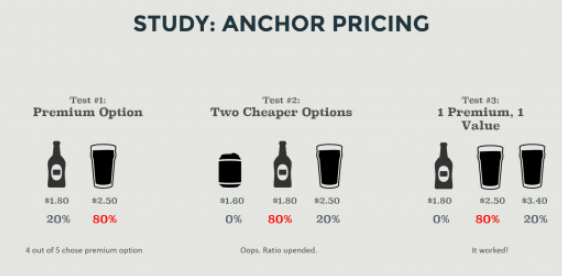If you think about it, sales is about using psychology at a fundamental level. Yet very few sales strategies even consider psychology. When you incorporate the fundamentals of psychology in your sales process it can have a dramatic impact on both sales performance and average spend. In this article we explore 6 key ways you can use psychology to increase your chances of selling, increase value perception, and increase average spend all at the same time. Keep reading for a 7th bonus tactic at the end.
1. Information Retention
The brain can retain three pieces of information plus or minus two. For example, if the viewer is fatigued and tired, the most they can retain is three items in their short term memory. If they are fresh as a daisy and on-form, they can retain up to 7 items in their short term memory. Keep in mind that no matter how alert the person is, retaining 7 items is a demanding task, and not an emotional experience we want them to feel when trying to influence a sale. We want the mental effort to be as minimal as possible, to ensure a smooth and pleasant experience towards buying. Having three options to consider ensures it’s easy for everyone no matter what.
2. Aversion to Extremes
People are drawn to seek out safety. We feel safe in between others rather than on the outside. We tend towards the safest option when making a decision. Logically, the middle ground is the safest choice because it’s not going to be too small and not going to be too large. The goldilocks “just right” principle applies here.
When choosing a pricing package, the viewer is drawn to the middle option because it’s generally the safest and statistically it’s the most popular choice (about 80% choose the middle option on average). For this reason, you should place the package you want to sell the most in the middle.
If you have four options, there are two middle options - visually this makes it less clear, and psychologically it forces a decision within a decision. Decision paralysis (aka paradox of choice) can then occur, leading viewers to choose against a package rather than choosing which package.
3. Anchoring & Price Perception
When someone sees information for the first time, they anchor it in their mind and use it as a benchmark for comparison against future information. For example, if the first price seen is $75, then seeing the same thing for $100 appears to be more expensive. Whereas if the first price seen was $150, seeing it for $100 makes it appear like a bargain.
Placing packages of different amounts next to each other creates an anchoring effect, whereby the viewer can make a comparison. This is why they put a $10,000 watch next to a $2,000 watch in stores - to make the $2,000 watch appear cheap by comparison. If the $2,000 watch was placed on its own, the viewer would have to use other benchmarks to make a value judgement, and then recall previous watches available for $100, thus making a $2,000 watch seem very expensive.
The bigger the difference is between the two price points, the better value the cheaper option appears, and the more expensive the higher cost option appears. This can be used to your advantage by intentionally placing the option you want to sell next to an extremely high priced option.
Anchoring works best when comparing two prices together. However when you factor in the benefits of Aversion to Extremes and Information Retention, the power of three makes it more effective.
4. Illusion of Control
When a viewer is given the impression that they have freedom and control over a situation, it puts them at ease and in a positive mindset. Inversely, if a viewer feels like they are being forced into making a decision, they exhibit ‘reactance’ which is an aversion or rejection to what you’re trying to get them to do.
By offering three pricing plans, you create the illusion of control, whereby the user feels free to decide which option suits them best, without feeling forced into an ‘all or nothing’ type decision.
5. The Power of Suggestion
As social creatures, we are influenced by what the majority of people think. It’s far more efficient to skip doing the hard research by following what others have experienced in the past. For this reason, by highlighting what package is the most popular, it influences the viewer to place more trust in that package, and enable them to consider it within a better frame of reference.
6. Number Psychology
We associate numbers with physical objects in our brain, to the extent that a large number appears to be large, whilst a small number appears small. Sounds obvious, right? But where it gets interesting is that even the shape of numbers and their perceived direction impact value perception.
For example, consider the below illusion. They are both exactly the same width, but the first line appears to be shorter than the second line.
<--->
>---<
This illusion applies to numbers as well. For example the shape of the number 9 is akin to > in our example above, whereas the number 6 is akin to <. So a number ending in 9 appears smaller than a number ending in 6.
Furthermore, the number 8 is blocky/chunky, and therefore appears larger.
This is why ending numbers in 9 instead of 6 or 8 makes them appear to be smaller.
Combining Heuristics
When combining the above heuristics, you can create a powerful pricing offer that not only improves decision making but also influences viewers to choose a higher value package. In other words, having the correct pricing structure increases average spend of your customers.

In the above example, Yale university performed three experiments.
Test #1: They had two options with a standard beverage and a premium beverage. In this instance, the safety heuristic comes into play, whereby we know that a premium option is probably the safest bet because higher price = higher quality. Customers only purchase the cheap option when they are sensitive to the price. You’ll notice the 80:20 rule here.
Average Spend: $2.36Test #2: By shifting the options along and adding a cheaper beverage to the left, they placed the middle beverage within a new frame of reference. Here, it’s safer to choose the middle option as it’s most likely to have the greatest balance of quality vs price. Unfortunately this flipped the 80:20 ratio which led to a large decrease in average spend.
Average Spend: $1.94Test #3: Instead of shifting the items to the right, they shifted them to the left, adding a super premium option and removing the super cheap option. The same ratio applied, but at a higher price point.
Average Spend: $2.68The average spend increased by 38% simply by changing the positioning of the beverage options.
How we would further improve the experiment
The experiment above is a good example of Anchoring combined with Extreme Aversion and the Illusion of Control. It’s a great example of how these techniques can influence average spend. What the experiment doesn’t cover is the quantity of sales achieved, and when designing pricing for your company, you want to make sure that sales not only have high average spend, but also high quantity. To facilitate easier decision making and increase the chances of a sale, we would apply The Power of Suggestion and highlight the middle option as “Most Popular'' and the far right option as “Premium”. These powerful suggestion tactics will guide the user with a frame of reference, and make choosing one an easier task.
We would also apply number psychology, and set the prices at $1.59, $1.79 and $2.49 respectively. This gives the illusion that the prices are lower and therefore better value for money. For the highest price option, we would keep the price as $3.40 or even increase it to $3.80 to extenuate the difference in price between the two comparison points - thus emphasising the value of the middle option further.

